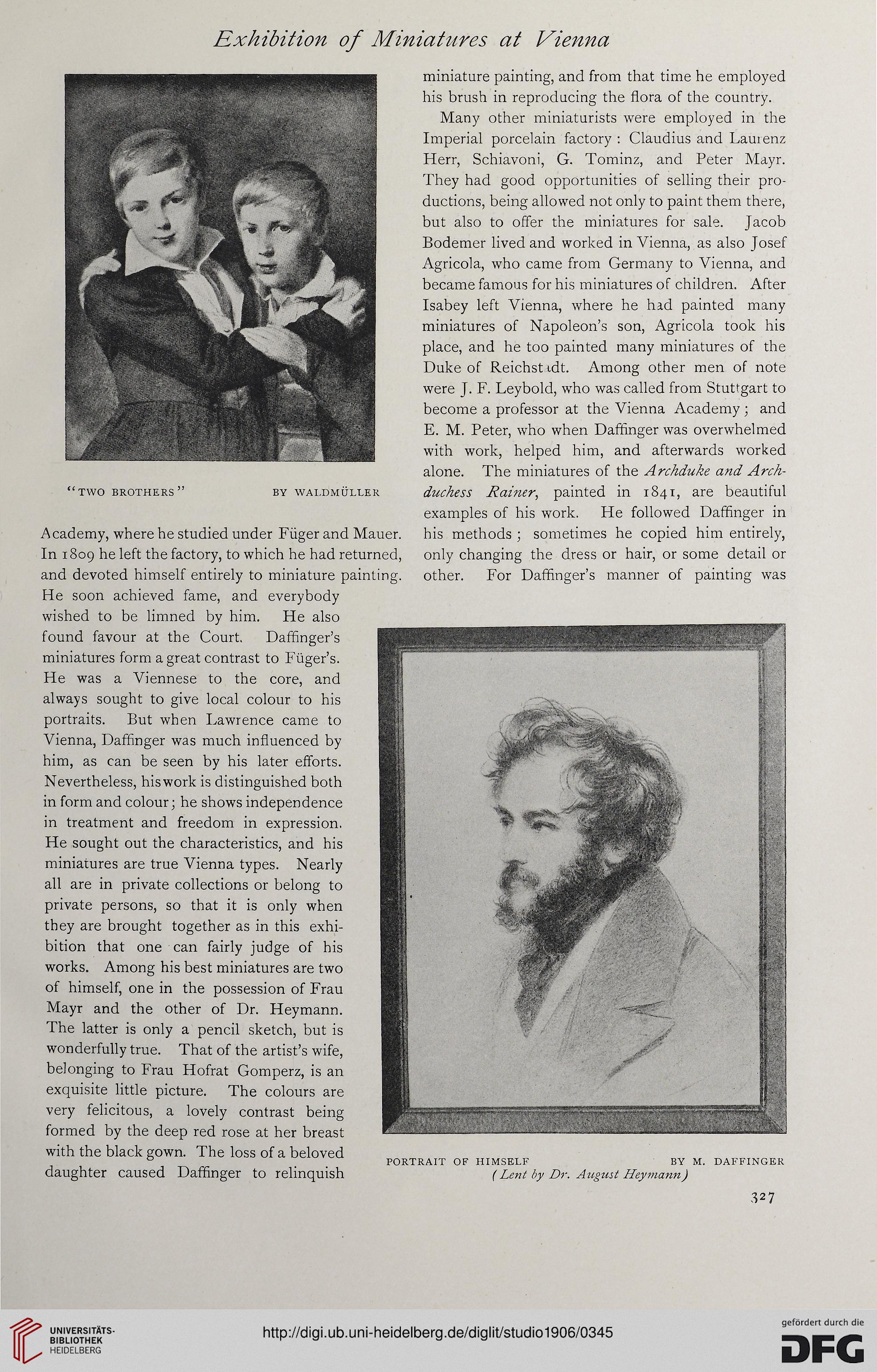Exhibition of Miniatures at Vienna
■ TWO BROTHERS
BY WALDMULLER
Academy, where he studied under Fiiger and Mauer.
In 1809 he left the factory, to which he had returned,
and devoted himself entirely to miniature painting.
He soon achieved fame, and everybody
wished to be limned by him. He also
found favour at the Court. Daffinger’s
miniatures form a great contrast to Fiiger’s.
He was a Viennese to the core, and
always sought to give local colour to his
portraits. But when Lawrence came to
Vienna, Daffinger was much influenced by
him, as can be seen by his later efforts.
Nevertheless, hiswork is distinguished both
in form and colour; he shows independence
in treatment and freedom in expression,
He sought out the characteristics, and his
miniatures are true Vienna types. Nearly
all are in private collections or belong to
private persons, so that it is only when
they are brought together as in this exhi-
bition that one can fairly judge of his
works. Among his best miniatures are two
of himself, one in the possession of Frau
Mayr and the other of Dr. Heymann.
The latter is only a pencil sketch, but is
wonderfully true. That of the artist’s wife,
belonging to Frau Hofrat Gomperz, is an
exquisite little picture. The colours are
very felicitous, a lovely contrast being
formed by the deep red rose at her breast
with the black gown. The loss of a beloved
daughter caused Daffinger to relinquish
miniature painting, and from that time he employed
his brush in reproducing the flora of the country.
Many other miniaturists were employed in the
Imperial porcelain factory : Claudius and Laurenz
Herr, Schiavoni, G. Tominz, and Peter Mayr.
They had good opportunities of selling their pro-
ductions, being allowed not only to paint them there,
but also to offer the miniatures for sale. Jacob
Bodemer lived and worked in Vienna, as also Josef
Agricola, who came from Germany to Vienna, and
became famous for his miniatures of children. After
Isabey left Vienna, where he had painted many
miniatures of Napoleon’s son, Agricola took his
place, and he too painted many miniatures of the
Duke of Reichst idt. Among other men of note
were J. F. Leybold, who was called from Stuttgart to
become a professor at the Vienna Academy; and
E. M. Peter, who when Daffinger was overwhelmed
with work, helped him, and afterwards worked
alone. The miniatures of the Archduke and Arch-
duchess Rainer, painted in 1841, are beautiful
examples of his work. He followed Daffinger in
his methods ; sometimes he copied him entirely,
only changing the dress or hair, or some detail or
other. For Daffinger’s manner of painting was
PORTRAIT OF HIMSELF BY M. DAFFINGER
( Lent by Dr. August Heymann)
32 7
■ TWO BROTHERS
BY WALDMULLER
Academy, where he studied under Fiiger and Mauer.
In 1809 he left the factory, to which he had returned,
and devoted himself entirely to miniature painting.
He soon achieved fame, and everybody
wished to be limned by him. He also
found favour at the Court. Daffinger’s
miniatures form a great contrast to Fiiger’s.
He was a Viennese to the core, and
always sought to give local colour to his
portraits. But when Lawrence came to
Vienna, Daffinger was much influenced by
him, as can be seen by his later efforts.
Nevertheless, hiswork is distinguished both
in form and colour; he shows independence
in treatment and freedom in expression,
He sought out the characteristics, and his
miniatures are true Vienna types. Nearly
all are in private collections or belong to
private persons, so that it is only when
they are brought together as in this exhi-
bition that one can fairly judge of his
works. Among his best miniatures are two
of himself, one in the possession of Frau
Mayr and the other of Dr. Heymann.
The latter is only a pencil sketch, but is
wonderfully true. That of the artist’s wife,
belonging to Frau Hofrat Gomperz, is an
exquisite little picture. The colours are
very felicitous, a lovely contrast being
formed by the deep red rose at her breast
with the black gown. The loss of a beloved
daughter caused Daffinger to relinquish
miniature painting, and from that time he employed
his brush in reproducing the flora of the country.
Many other miniaturists were employed in the
Imperial porcelain factory : Claudius and Laurenz
Herr, Schiavoni, G. Tominz, and Peter Mayr.
They had good opportunities of selling their pro-
ductions, being allowed not only to paint them there,
but also to offer the miniatures for sale. Jacob
Bodemer lived and worked in Vienna, as also Josef
Agricola, who came from Germany to Vienna, and
became famous for his miniatures of children. After
Isabey left Vienna, where he had painted many
miniatures of Napoleon’s son, Agricola took his
place, and he too painted many miniatures of the
Duke of Reichst idt. Among other men of note
were J. F. Leybold, who was called from Stuttgart to
become a professor at the Vienna Academy; and
E. M. Peter, who when Daffinger was overwhelmed
with work, helped him, and afterwards worked
alone. The miniatures of the Archduke and Arch-
duchess Rainer, painted in 1841, are beautiful
examples of his work. He followed Daffinger in
his methods ; sometimes he copied him entirely,
only changing the dress or hair, or some detail or
other. For Daffinger’s manner of painting was
PORTRAIT OF HIMSELF BY M. DAFFINGER
( Lent by Dr. August Heymann)
32 7





